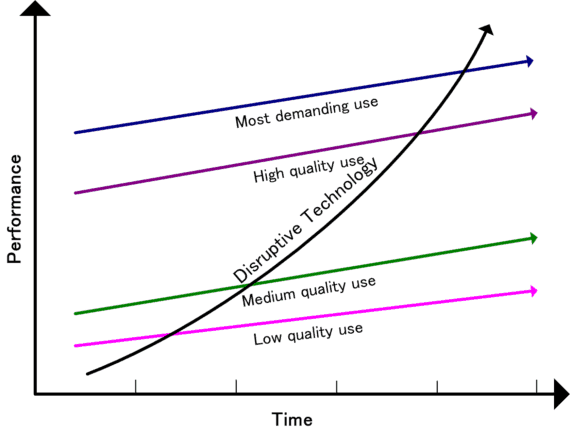“What startup strategy should I be using?” – Every entrepreneur ever.
Every entrepreneur in history has tried to answer this question in one way or another. Trying to find the most innovative business model, method or strategy to achieve maximum success. But has anyone found that true strategy which will guarantee success?
The short answer? No. It doesn’t exist.
But the basic elements of a business strategy remain unchanged, neatly summed up into two parts as Joan Magretta explains:
“Part one includes all the activities associated with making something: designing it, purchasing raw materials, manufacturing, and so on. Part two includes all the activities associated with selling something: finding and reaching customers, transacting a sale, distributing the product, or delivering the service. A new business model may turn on designing a new product for an unmet need or on a process innovation. That is it may be new in either end.” – Joan Magretta, author and Senior Associate at the Institute for Strategy and Competitiveness at Harvard Business School.
Every business is different, every market is different, and you can bet that every entrepreneur is different. So therefore every business model or startup strategy is inevitably different.
Your job is to find the right kind of strategy that works best for you and your business. Because there really isn’t a one-size-fits-all method when it comes to the confusing world of startups and entrepreneurship.
There are dozens of startup strategies out there for you to try, but unfortunately you don’t have time to resources to try them all. So I’ve broken down the most popular and intriguing startup strategies for you. Using the power of research, case studies, and data I’ll break down each strategy and figure out the pros and cons of each strategy.
3 Proven Startup Strategies
Every startup is different, so don’t do yourself the disservice of wasting time on something that isn’t maximizing your potential.
1. Get Big Fast
During the late 90s businesses were ruled by a single mantra “Get Big Fast”. It follows a simple logic: prioritize growth over profitability, dominate the market before competitors, and customers and profit will naturally come.
It doesn’t take a genius to see the benefits of this strategy. It heavily relies upon the availability heuristic where big events are more likely to stay in a customer’s mind and therefore be discussed. And the AIDA model, the basic marketing formula of raising awareness, to generate interest, which then leads to desire, and finally prompts action.
It’s pretty much the “Build it and they will come” mentality. The Get Big Fast model relies on the assumption of an eventual capital profit. Theoretically, by raising as much awareness as possible you’ll be able to have a higher rate of interest, desire, and action than those who don’t right?
Not necessarily. In fact the majority of those who use this business model end up failing.
I point to Webvan, Pets.com, and govWorks as classic examples of businesses that folded due to improper scaling.
I’ve written about Webvan previously, but for all those don’t know Webvan was the first grocery delivery service of its kind. Their service initially proved to be popular, after this early validation they immediately announced that by 2001 they would expand to 26 major cities, which included building custom warehouses at the cost of $30 million each.
“Webvan committed the cardinal sin of retail, which is to expand into a new territory before we had demonstrated success in the first market. In fact, we were busy demonstrating failure in the Bay Area market while we expanded into other regions.” – Mike Moritz, former Webvan board member and partner at Sequoia Capital.
Despite being popular Webvan proved that it wasn’t too big to fail, it was a logistical nightmare. Founders and investors were left dumbstruck as they hemorrhaged money through its rapid expansion of infrastructure only to find out that they possessed a faulty business model. They finally closed in 2001 after losing $830 million in its last two years of operation.
Pets.com may not have been the largest flop of the dotcom era, but it certainly was the most prolific. The founders reportedly spent $11.8 million on advertising, $1.2 million of which went to a national Superbowl TV ad in an effort to build brand awareness. Soon everyone was talking about them, and investors began pouring in. The logic was simple, the higher the rate of awareness and interest, the more desire and action right?
Turns out they were only earning annual revenues of $619,000. The complete lack of market research and validation was Pets.com’s downfall. There just wasn’t a market for home-delivered pet food and accessories. Although 70% of people have a pet in their home, people just weren’t interested. A cautionary tale for anyone believing that awareness immediately leads to sales.
Unlike the previous two examples govWorks actually teetered on the edge of success before crashing. It was a business truly ahead of its time, an online portal allowing citizens to pay for parking fines, apply for jobs, and look up city information.
govWorks was founded in 1998 and quickly expanded, ballooning from two employees to 250 in 14 months, they quickly started to reach out to other city councils, and investors came pouring in. However the founders were inexperienced and made costly mistakes along the way: like underestimating the time it would take to build the core of its system, and offending government officials who were their primary investors. They simply weren’t equipped to expand that quickly. The business would eventually go on to burn $60 million in venture capital. It was eventually sold in 2001 and a documentary titled Startup.com was released the same year detailing their rise and fall.
But that doesn’t mean that the “Get Big Fast” model can’t work. It can work under the right conditions and with the right strategy involved.
Jeff Bezos is famous for steering Amazon on a purely growth focus. Despite only managing to turn a profit in 2003, 9 years after its inception. Amazon defies conventional wisdom by refusing to fail. By purely focusing on growth and not on profit it can focus on retaining customer loyalty, building brand awareness, and expanding its infrastructure.
Amazon is now thoroughly ingrained into the culture of day-to-day life and it absolutely dominates the field of ecommerce. It could be years before Jeff Bezos finally scales down and cashes in his chips, but Amazon shows no signs of slowing down its consistently increasing annual revenue.
More modern examples would be Yahoo buying Tumblr for $1.1 billion, or Google acquiring YouTube for $1.65 billion. Both companies failed to turn a profit during its formative years, but managed to demonstrate that by rapidly expanding and cultivating a strong desire within the community it is possible to turn a profit through capital gain.
You probably haven’t heard of Taobao but it’s currently the largest ecommerce site in China, and they have a fascinating David-and-Goliath story. In 2004 eBay acquired EachNet.com, which enjoyed an 85% market share at the time, and within the same year Amazon acquired Joyo.com. Right off the bat the two US companies became kingpins of the e-commerce market in China.
However Jack Ma, CEO and founder of Taobao, had other plans. He was determined in growing Taobao’s reach and sacrificed profit in order to maximize its reach. It allowed free listings for business owners, focused on meeting customer satisfaction, and building brand loyalty. By 2005 their market share grew from 8% to 59%, while eBay China witnessed their market share plummet to 36%. eBay would eventually shut down its China site sometime in 2006.
The Get Big Fast strategy works if done right. But, more so than anything else in business, is a massive gamble that you have to ask yourself if you’re willing to take.
Don’t Skip: 14 Low-Cost Startup Ideas That’ll Save You Money
2. Lean Startup Method
I think it’s pretty safe to say that New York Times bestseller The Lean Startup by Eric Ries can be considered the bible for entrepreneurs everywhere this decade. It’s impossible to walk into any startup incubator, networking event, or business panel without having someone giving it a mention.
For all those somehow left in the dark, the Lean Startup Method relies upon these key principles: go to market quickly, constantly validate and iterate, and keep costs low.
The Lean Startup Method is a direct reaction to the dotcom bust and the Get Big Fast strategy that led many to financial ruin. Lean startup instead employs the strategy of focusing on short-term profit over growth, to ensure the long-term life longevity of a business.
But the Lean Startup Method has actually already existed for years before Ries brought it to mainstream attention. The origin of the lean method lies in Japanese manufacturing, with companies like Kaizen and Toyota heavily relying upon the philosophy of constant improvement. Elements of the Lean Startup Method can actually be found in Steve Blank’s book The Four Steps to the Epiphany: Successful Strategies for Products that Win published in 2005. Interestingly enough, Ries was actually Blank’s student at Stanford and Blank would later on become a major investor in one of Ries’s early startups.
I also invite you to take a look at the similarities between the Lean Startup Method and the OODA loop, developed by USAF Colonel John Boyd. Initially designed as an decision making strategy for pilots engaged in aerial combat. But it’s also, as you can see, incredibly applicable to business as well.
However going lean may not be suitable for every startup. A study found some inherent flaws within the Lean Startup Method, which I’ll break down as follows:
“First, the principle of get out of the building was considered hard due to barriers in accessing the customers.”
It’s difficult to find customers, or interest, right out of the gate. Outside of direct conversation it’s difficult to gain customer feedback, especially when what you need is an unbiased focus group. Validating your idea has to come from more than just your family and friends.
Recently Joel Gasgoigne, CEO and founder of Buffer, wrote about his experience using the lean method to build Buffer in this issue of Foundr Magazine. Gascoigne used Twitter to gauge interest in his idea, even offering a price list before he even had a product to see how many people clicked through and showed interest. Once he saw that people were interested, that’s when he started developing his minimum viable product.
“Second, the principle of ‘pivot if necessary’ was difficult to be implemented because of the lack of big problems. In the case study, the problem that was validated was a minor problem and solution offered was an incremental product in the end.”
Blank himself notes that one of the greatest restrictions for startups in pivoting is the lack of resources to pursue every possible variation. Entrepreneurs have to make a gamble and decide on what the best potential iteration is to be.
Unless entrepreneurs have a clear vision, they run the risk of becoming a victim to mental traps like the equality bias, or the Dunning-Kruger effect.
It could go either way if you lack vision. Your idea could be constantly validated by a small and biased group of people, and you’ll eventually be blinded by your ego. Or your sparks of innovation are drowned out by the many voices of opinion.
“Third, the principle of quick iteration was also a problem. The barrier faced in this case is the speed of iteration.”
Speed is the crux of the problem when it comes to the Lean Startup Method. When it comes to designing a quality product, the process is inherently slow. It’s a reflective and contemplative process that requires much time and thought.
A major flaw of the Lean Startup Method is that while it encourages innovation, it discourages creative solutions. Businesses who choose to run lean have to produce a product that fits pre-existing models and market, there’s almost no room for out-of-the-box thinking.
“Lastly, the principle of the Minimum Viable Product (MVP) was causing confusion in its implementation it caused confusion as the purpose of MVP is to get the MVP created as quickly as possible to capture the customer’s interest. There was also a reliability issue where the company was determined not to create a poor product for its MVP but couldn’t afford in going too far developing the whole product as it is too risky.”
The flaw of MVP is that it encourages founders to focus more on features than a whole product. This is more on the fault of entrepreneurs who misinterpret ‘minimum’ as an excuse to rush an incomplete and fractured product to market, a move that is devastating to a company.
However it can be done right, Blue River Technology spoke to 100 potential customers over a 10 week period about their idea of an automated lawn mower. Their target market, golf courses, weren’t interested but they were able find that such a product was in high demand with farmers. It was only then they began developing their MVP, releasing a prototype within 10 weeks. It took nearly two years before they were ready to release a commercial product.
The Lean Startup Method prides itself on being agile and constantly learning. Only taking the best and leaving the rest. It’s a great movement to be a part of and it’s certainly inspired many young entrepreneurs and given a sense of rejuvenation throughout the startup community.
The method itself is quite sound and is widely applicable to a diverse set of businesses, many of the problems seemingly stem from misinterpretation of key terms.
3. Stealth Mode
Another popular business strategy during the dotcom era, Stealth Mode almost lies in the middle between Get Big Fast and Lean Startup Method. It focuses on: expanding a strong product and infrastructure foundation, as well as employing an iterative process on research and design.
All of this is done in completely secrecy until launch.
It’s not uncommon for key personel to sign non-disclosure agreements and to have departments work remotely from one another. Some employees don’t even entirely know what the business that they’re a part of even is!
To really appreciate the benefits of Stealth Mode requires a little explanation into ‘disruptive innovation’ and what it means.
Disruptive innovation is a term coined by Clay Christensen, professor of Business Administration at Harvard Business School and considered the world’s most influential thinker of 2011 and 2013 by Thinkers50. It describes the process when an innovative product or services that manages to disrupt the current market by providing something that was not historically available to consumers before. Watch it explained from the man himself.
Successful businesses end up becoming out of touch to their customers by either over-innovating or becoming stagnant by virtue of its dominance over its market. Disruptive innovation takes place when a product bucks the historical trends and provides something completely new. And thus dominate the market due to their uniqueness, even if the product is inferior to more established products.
Entrepreneurs and small businesses are in a unique place to be able to do just that. Unlike larger companies entrepreneurs are closer to the ground, are more connected to what customers want, and have more freedom for creative and innovative thought.
Christensen uses the example of personal computers. Computers used to be giant machines that cost millions to build, the advent of the personal computer allowed a computer in every household. Despite it performing worse than it’s larger counterparts, it was exactly what the market was looking for.
A modern example would be Pebble, the smartwatch that raised over $10 million within 30 days on Kickstarter. The first smartwatch that was compatible for both iOS and Android, it was a groundbreaking success that led tech giants Google and Apple scrambling to play catch up. The story of Pebble also highlights another key aspect of disruptive innovation, that all the conditions have to be just right for such innovation.
While you don’t necessarily need to go into Stealth Mode to achieve disruptive innovation, it is a strategy that prioritizes innovation and product before anything else.
Take a look at AppLovin, a mobile advertising network, where it operated in Stealth Mode for two years. They were able to generate pre-launch buzz and had acquired over 300 brands as users by the time they officially launched. Two months after its official launch, AppLovin achieved a $100 million revenue run rate.
“It can be tempting to equate success in the press with success in business, and if you get too much coverage, you can start to believe the hype. But being in stealth and maintaining our obsession of building a cash-flow healthy business kept us hungry and helped us focus on the product instead of the more glamorous distractions.” – Adam Foroughi, CEO and founder of AppLovin.
One the other hand Stealth Mode can be a costly strategy at the most vital stage: the public launch. While you might alleviate pressure during the initial stages of Stealth Mode, as you draw closer to the public launch the pressure to perform skyrockets. Especially if you’ve garnered huge amounts of buzz and hype.
Sean Parker, of Napster and Facebook fame, launched Airtime after raising $33.5 million pre-launch. The public launch even featured heavyweight celebrities like Jim Carey, Jimmy Fallon, and Olivia Munn. And it was a complete disaster. Embarrassing is putting it lightly.
The launch demonstrated the many bugs and glitches on the video chat platform, the microphones even stopped working at some point, Airtime utterly failed at living up to the hype. Despite spending over a year in ultra-secret development, it was clear that a groupthink effect had taken place and the lack of outside opinion had jeopardized what could have potentially been an amazing product.
One of the major flaws of Stealth Mode is the near-complete refusal to accept any outside opinion or help. Diversity of opinion breeds innovation and by removing that diversity founders cripple themselves and their business. Despite the amount of time and effort put into a project, founders will ultimately have no quantifiable validation that their idea is even a viable product.
However Stealth Mode doesn’t necessarily need to be for the purpose of product innovation. Coravin is a business that sells a tool of the same name that allows users to extract wine from a corked bottle whilst leaving the cork intact and preserving the wine inside. For any non-sommeliers out there, this device would revolutionize the high-end wine industry. Coravin was founded in 2011, and didn’t publicly launch until 2013.
Yet the patent for the first prototype existed as far back as 2005 and was already publicly available. Stealth Mode in this case wasn’t used to solely protect intellectual property but as a clever way to ensure the best possible launch for their product.
“The whole concept of ‘new’ is very precious. People are inundated with news all the time, and marketing claims they don’t believe. The other part of it is that the world of wine is a very connected world and very driven by influencers. We made that work for us.” – Nick Lazaris, CEO of Coravin.
Coravin was well aware of the inherent distrust their target market would have of their product. So by requiring journalists, sommeliers, and industry partners to sign strict non-disclosure agreements Coravin was able to sidestep any potential negative press and strategically place themselves in the best position to publicly unveil their product the way they wanted. By inviting select journalists and key influencers to the public launch they ensured the best possible reception by their target market.
The general consensus remains that it is an out-dated strategy that fails more often that it succeeds. However as AppLovin and Coravin have demonstrated, Stealth Mode is still a viable startup strategy today when used within the right context.
Keep Learning: How to Start a Startup (Advice from Those Who’ve Done It)
Now It’s Time to Implement Your Startup Strategy
It’s important to remember that these strategies are only mere guidelines and not hard and fast rules that you have to follow. Just like any other tool, you have to use the right one for the job. Some startups will benefit more from Stealth Mode than they would Lean Startup Method, and vice versa. It’s up to you to understand what are the most important values within your business and to figure out the best strategy to exemplify these values.
Smart entrepreneurs will incorporate bits and pieces of each strategy and let it evolve and tailor itself to their business. Astute readers would have noticed the common elements within each of these startup strategies.
You’ll notice that many of the successful case studies never strictly adhered to the ‘rules’ per each strategy.
The marketplace is constantly changing. As the world develops and grows, entrepreneurs will have to learn how to adapt and evolve with it. New strategies will be developed and startups everywhere can find both success and failure with them depending on how they’re utilised. I encourage you to experiment and find the perfect solution for you and your business.
To get help forming your startup strategy, explore our free training to learn everything from financing to content marketing for your startup.






















